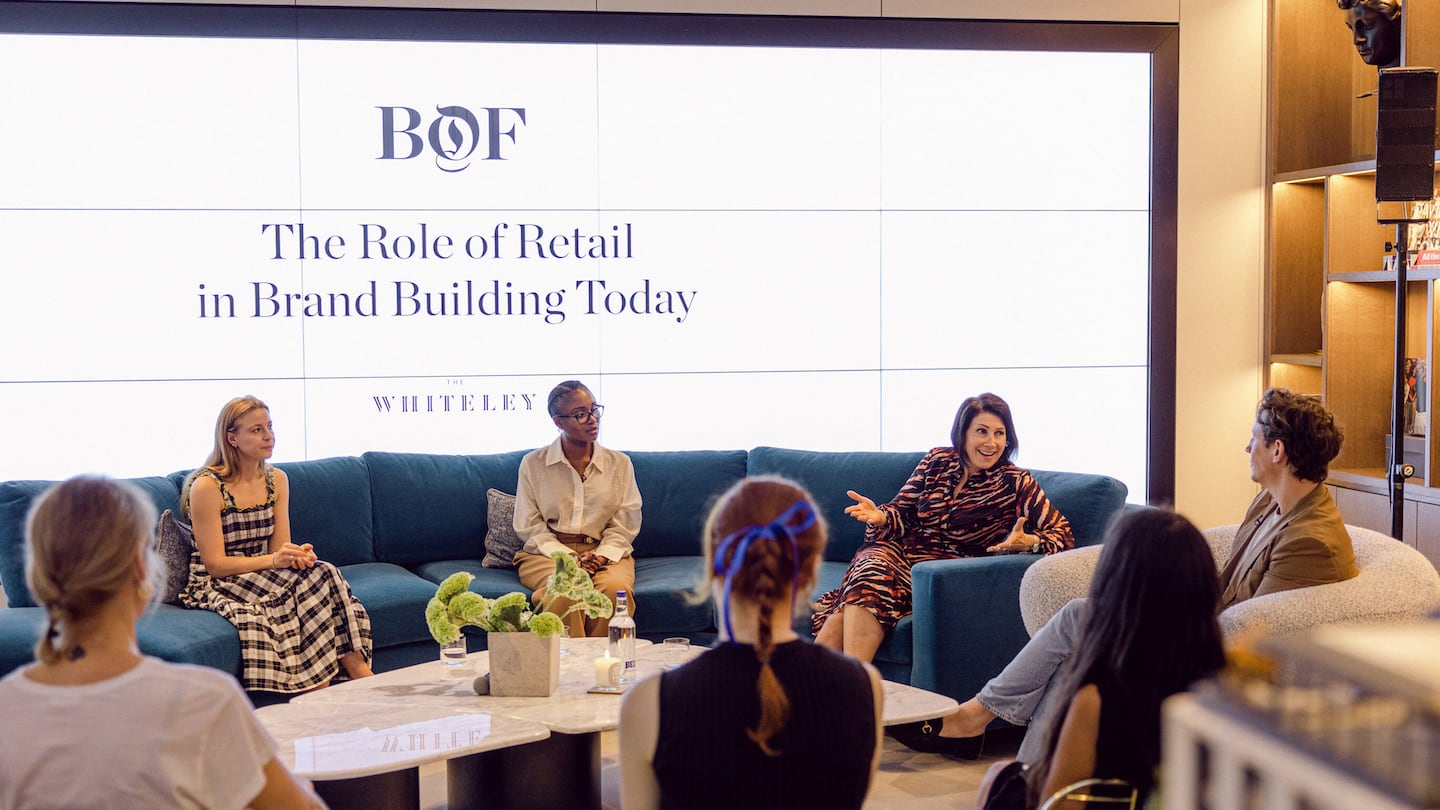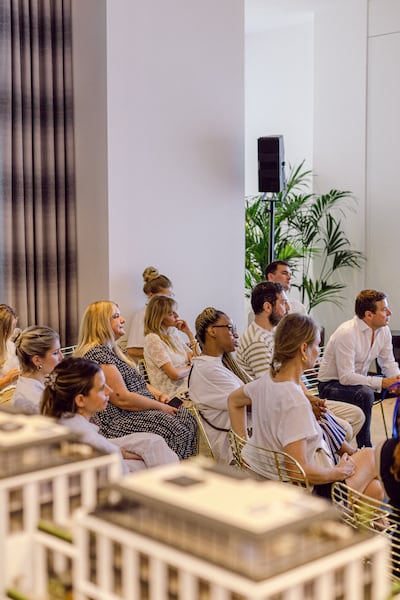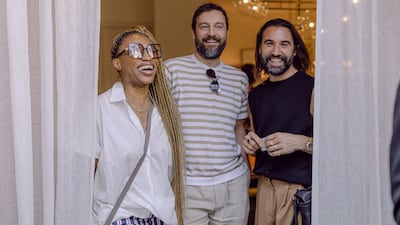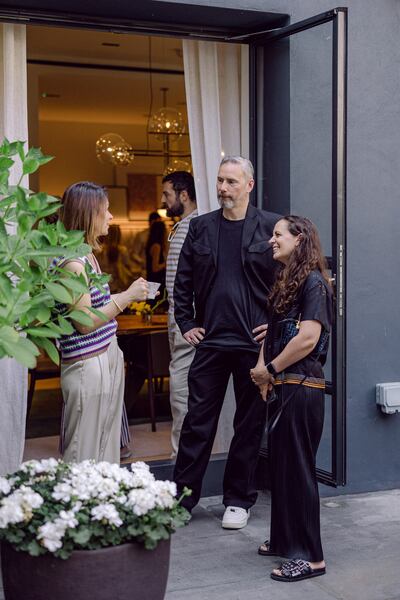
The Business of Fashion
Agenda-setting intelligence, analysis and advice for the global fashion community.

Agenda-setting intelligence, analysis and advice for the global fashion community.

Globally, retail footfall is bouncing back following the turbulence of the pandemic and its lockdowns. However, the character of physical retail is decidedly not set to return to its pre-pandemic form, as consumer desire for discovery, experiences and connection, as well as the increasing interaction of digital and physical offerings, fundamentally shifts what a store is for in the future.
Consumers are also becoming more cautious about their discretionary spending in most regions, according to BoF and McKinsey’s State of Fashion 2023 report. Europeans intend to make the biggest spending cuts on apparel, footwear, accessories and jewellery. Analysts expect shopping trips will become less frequent, but will include longer dwell times as a result, creating significant opportunities for community engagement and brand building. Hybrid working also plays a key role in diminishing footfall in city centres and a growing focus on local offerings.
Consequently, optimising consumer touchpoints is critical on the shopfloor — with success rooted in sales associate training, connecting products to purpose, grounding experiences in the local community, and truly understanding the consumer base in data analytics. Some 72 percent of fashion executives surveyed in the State of Fashion 2023 report also planned to increase prices and 37 percent expect to focus on cost improvements in 2023.
To better understand how to execute a compelling physical retail strategy to build small to medium-sized brands, BoF and The Whiteley London hosted a panel in London, adjacent to the new Foster + Partners designed development, that features a 19th Century Grade 1 listed facade, a Six Senses hotel, 119 state of the art apartments and 19 retail units.
Inviting market leaders and innovators to share their insights and tactics for driving performance today, moderated by BoF’s Head of Content Strategy, Robin Mellery-Pratt, the panel featured Rebecca Morter, founder and CEO of Lone Design Club; Ruth Jacob, the course leader for the MA in Fashion Marketing & Global Cultures and acting course leader for MA Global Fashion Retailing at London College of Fashion; and Diane Wehrle, marketing and insights director at Springboard.
Now, BoF shares some key insights from the panel talk on the role retail plays in building a brand today.
RM: For small businesses, the first place to start is to get into the data and know exactly what’s pushing the needle. Going back to basics, how you approach online — do the same in a physical space. We are not yet there physically as we are online. We’re not pulling out the data in the right way.
I am a big fan of things like QR codes — it’s very basic, but they do work. They are a really great way to capture journey mapping, see what people sign up to, incentives, little personalised messages as you go around the space. Ultimately, it comes down to the physical and digital experiences having to be connected.
DW: Even the largest retailer clients have no idea how many people walk past their store and how many of those people then come into their store. They have no idea what their conversion rates are. So, they have a benchmark against which they can measure the performance of the store.
Understand how your trading location is performing by counting the people who walk past and then understand who comes in, then you can understand what your power hours are — when you are most busy and least busy, and when you are most successful in selling. When you have that basic level of data, you can build on that and that equates to the data you have online.
RJ: Something as simple as finding contact details can mean you can get in touch with your consumers later on if they have any questions or queries, if you want to let them know about new products, about an event or let them know about something that’s of interest to them. Just having those contact details means that you can then interact with them online.
DW: In our quarterly survey of consumers, we ask people what are the three things that drive them towards a shopping destination and product is the most important thing on people’s minds. There’s been a lot of issues around stock availability, but people get disappointed quickly if they turn up and you can’t buy what you want and you don’t have choice. So certainly, local is important, communities are important, but also products.

RM: For physical retail, people are coming in for a product because they want to see, try, touch and feel. Online is fantastic but it is not there yet to replace the in-store experience and I don’t think it ever will be, purely because of the way that we feel as humans, when we interact with something and build a meaningful relationship. They’ve seen it online and loved this brand, but they may need to come to feel a part of something. And I think that’s what online shopping is missing — sometimes it’s that sterile environment.
What we want as customers, from the high street and from the physical experience, is just changing. It’s not going anywhere, but it’s about how digital and physical can interact seamlessly and actually create a seamless experience for shoppers in-store and online.
RM: For us, 38 percent of our orders during the day will come from an event. Then, 80 percent of customers that started their purchasing journey with us started by attending an event, whether they purchased on that night or came back a few days later, which is quite common. But that is why they came and made the effort — it’s that experience.
People — ambassadors, voices, influencers — relevant people in your space are going to add a different perspective to the story you tell. Bringing in people from the design team, from different parts of the company to connect, in real life, with customers is so powerful. Customers love to meet someone from the team, whether it is a designer or the founder or even just people close to the business because nobody can sell the brand like the person who created it. That power is really authentic and it’s genuine. You will never forget that.
RJ: Gymshark recently sent out an invite to attend a running club within their Regent Street store, so people can come there, work out in the store space, and the idea is that after, they would send photographs of the day to the people who attended. I couldn’t attend but I did receive the pictures, and you can see the community. You could see people wearing the clothes, in the physical space — that sense of community was so strong, so evident, and it doesn’t even feel like you’re shopping or spending money. It feels like you are sharing, you are experiencing, you are living life.
DW: Telling your customers about your products within a social environment is great. It’s nice to go into a store, we look at a fabric, we look at the label to see where it was made, and you have someone tell you a little bit about it. But actually, if you can personalise that and you can create a much greater knowledge around the products that they are buying, you feel more ownership of that and you feel more loyalty to that because you do feel you are part of the group who have bought into that brand. You’re the agent for those people who created the garment, to tell customers about the whole production process.
RM: The younger generation has grown up shopping online, so they understand convenience, they understand simplicity. They don’t need to go to Boots for a product they know how to buy online. What they want, as social creatures, is experience, community and storytelling.

That’s really what the high street’s role is for this young shopper — it is a space to connect, to be part of something. It’s a space to learn, to educate themselves, whether that is in terms of sustainability, about a new brand. They want brands they have never seen before, they want to be excited and they want to be surprised. You can’t get that as much online. It’s going in that direction in terms of personalisation, but that surprise, that excitement, that tiny experience you give your customer, is so valuable for your brand building.
RJ: With cosmetics, things like smart mirrors and augmented reality offer a novelty, a surprise, something that can be factored into the retail experience. A smart mirror can detect who’s standing in front of it, so people have to be like gender, facial expressions, potentially emotions.
That tiny experience you give your customer, is so valuable for your brand building.
The Nike app can also tell if you’re in a store, and then a banner on your phone would welcome you by name. As well as knowing your customer, it’s good to know your location as well. Knowing your location means you know your customer.
RM: When you look at different locations for your stores, there needs to be an essence of uniqueness that is suited to the demographic in that location, because the locals will build a rapport with you and come in. I think it’s being able to understand the nuances and understand those more targeted relationships and what the local customer really wants from a brand, and allow the business to be flexible in those areas.
Every location has different nuances and you have to understand the relationship between the two because the physical store will reduce your customer acquisition costs, it’ll increase your lifetime value, it’ll reduce your return rate. But you can’t be looking at physical space differently to your online space — the data you’re looking at needs to be a total hybrid.
RJ: All over London, looking at particular locations, looking at boutiques and where they are set up in locations, what stores are next to them, what other brands, knowing that can give you an idea of who your customers will be. If this brand is in the store, will my ideal customer be here as well?
The data you’re looking at needs to be a total hybrid.
DW: During Covid, we rediscovered our smaller high streets — the importance of local and independent. We discovered those butchers and bakers, the small delis and fashion stores that we just didn’t know about because we were all in our offices all the time. A lot of that loyalty has been maintained but the onus is on the retailers to make sure their standards and proposition is as good as it can be, as there is a tendency to become a bit laissez-faire about it and just assume people will come back.

RJ: It’s customer service and staff within that physical environment — the insights, the knowledge that they can give consumers relating to product and uses. A term that I come across from teaching is relationship marketing and it’s something that’s a subtle way of being in contact with your customer, knowing your audience and what they like, what they dislike, and having that relationship with your customer is so important [...] and something that can’t be replicated online.
RM: We put our headquarters team into all the stores and the sales in each of those stores increased something like 200 percent in a day. We had an e-commerce coordinator who did the best and she has never done retail in her life. It’s because they are bought in. They are incentivised, they are invested, they are bought into the brand and not just there to get a nine to five. You need to have skin in the game.
Physical retail as a role is evolving — the job is evolving. It is not “a store manager” anymore, so don’t call it one. Create the role that fits. You have to give somebody more responsibility and a progression plan that goes beyond being in the store for the rest of your life, whether it’s a stepping stone to moving into headquarters or everybody in certain departments doing time in stores and they are hybrid roles or something. It’s early day experimentation.
The job is evolving. It is not ‘a store manager’ anymore, so don’t call it one.
Sustainability and value alignment is the most important thing for younger people. They will do more when they feel like they are part of something that’s having a wider impact than just a shop that is contributing to the problem we are in. Bringing out that authenticity and that relationship — people are more bought in, contributing to a business that’s helping.
DW: Arm all your colleagues with iPads and technology to have up-to-the-minute information and enable the customers to get it as quickly via the store as they would when buying from home, online. Motivate your staff to collect data on customers and engage with customers. A lot of our bigger retail clients are looking at that now, and it’s about trying to maximise and increase colleague interaction with customers. Unless they motivate and provide bonuses for colleagues to do that, they won’t do it because it’s easier not to engage.
The Whiteley is the large-scale reimagining of the former Whiteleys shopping centre in London’s Bayswater. Designed by Foster + Partners, The Whiteley will feature 139 world-class, modern residences, twenty new shops and restaurants, a cinema, a large-scale gym, a high-profile public arts programme and London’s flagship Six Senses hotel and spa with 110 rooms, as well as its social wellness club. A joint-venture development between MARK and C C Land, with Finchatton acting as development manager, The Whiteley is set to complete in 2023.
Beyond its footprint, The Whiteley will herald significant public realm improvements, providing a beating heart to Queensway for both residents and the wider neighbourhood and communities to enjoy. Collective landowner investment will allow for over half of the street’s existing fabric to be revitalised, bringing grand pavements, new retail opportunities, workspaces and restaurant operators into the wonderfully eclectic mix, while providing a new gateway and runway to central London’s largest Royal Park, Hyde Park.
This is a sponsored feature paid for by The Whiteley as part of a BoF partnership.
As the German sportswear giant taps surging demand for its Samba and Gazelle sneakers, it’s also taking steps to spread its bets ahead of peak interest.
A profitable, multi-trillion dollar fashion industry populated with brands that generate minimal economic and environmental waste is within our reach, argues Lawrence Lenihan.
RFID technology has made self-checkout far more efficient than traditional scanning kiosks at retailers like Zara and Uniqlo, but the industry at large hesitates to fully embrace the innovation over concerns of theft and customer engagement.
The company has continued to struggle with growing “at scale” and issued a warning in February that revenue may not start increasing again until the fourth quarter.